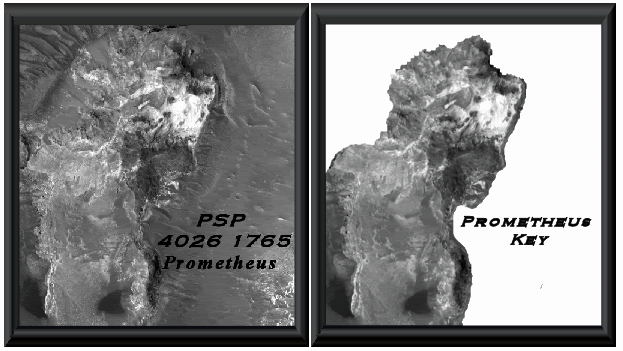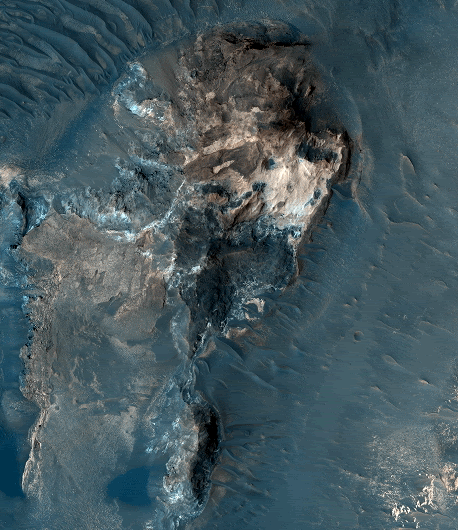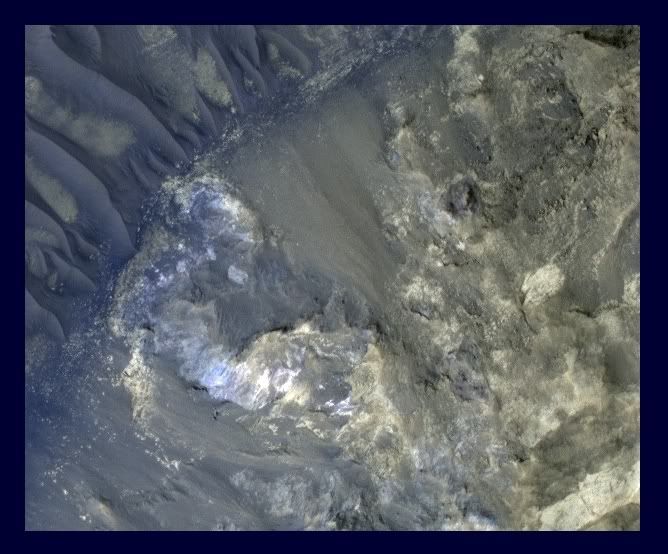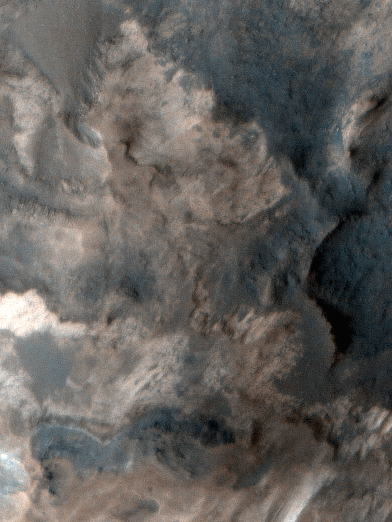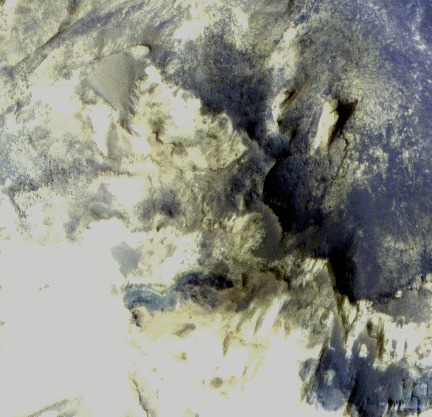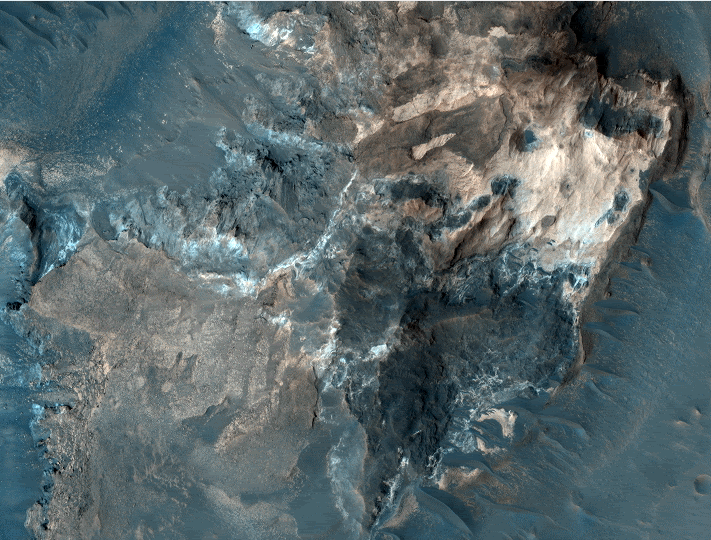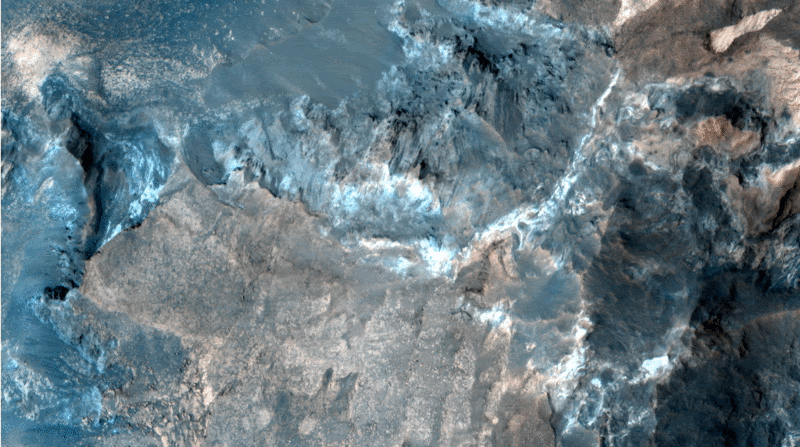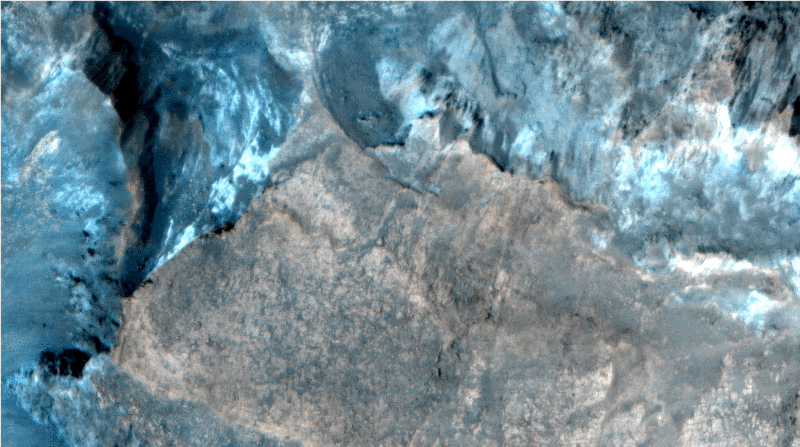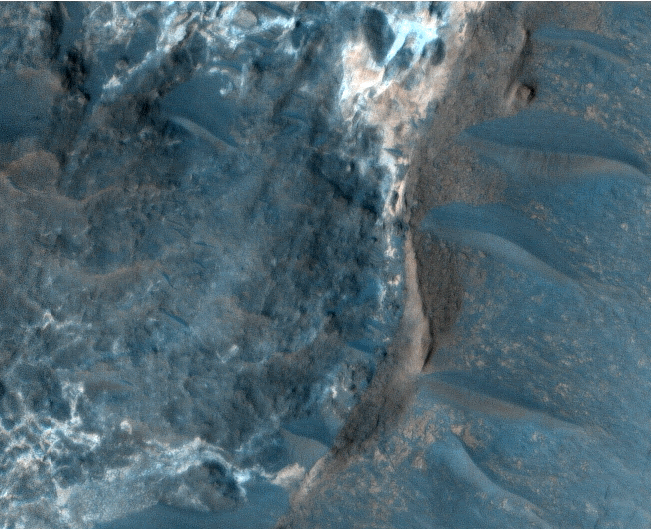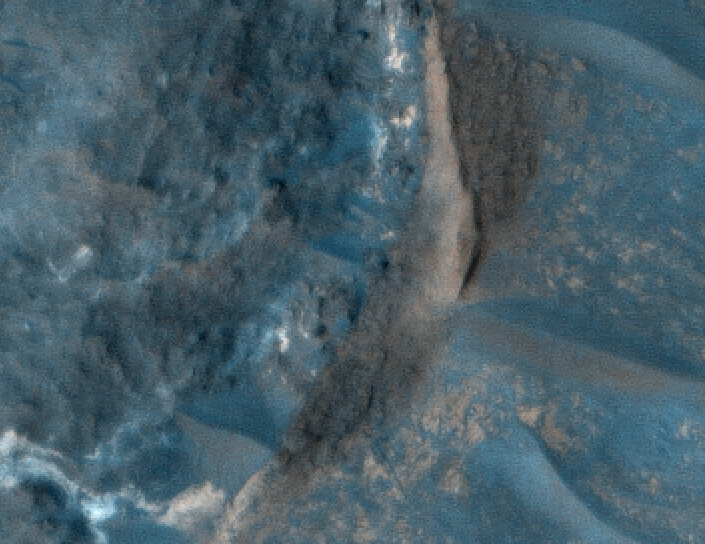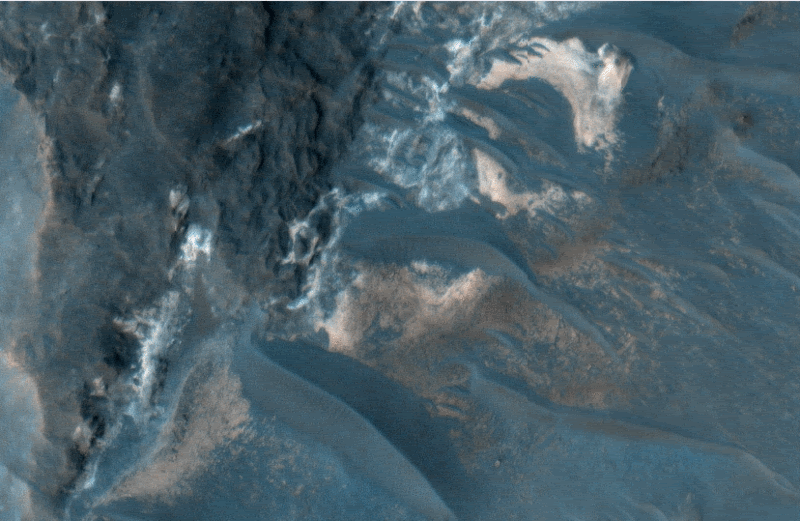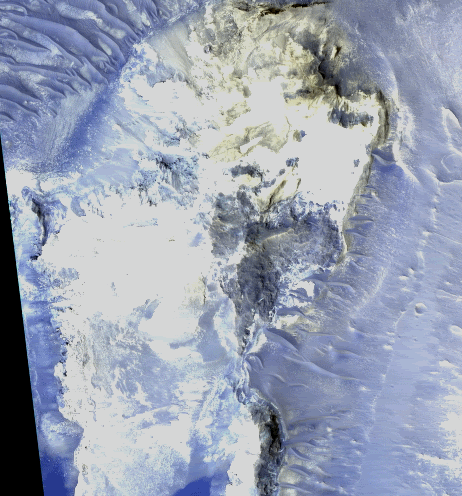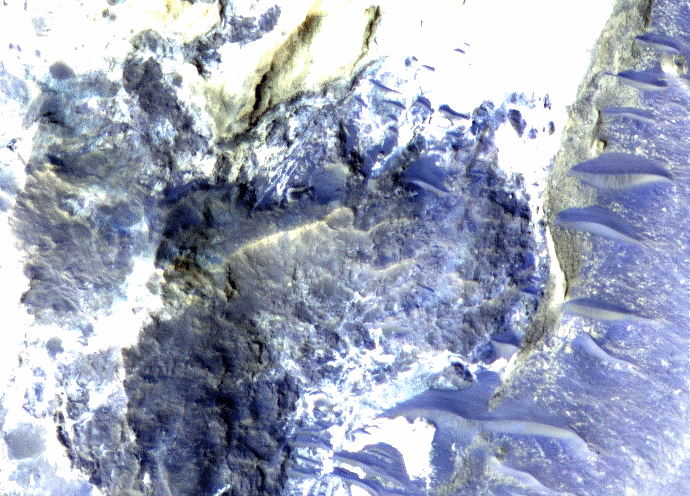- Thank you received: 0
Faces from the Chasmas
- neilderosa
-
- Offline
- Platinum Member
-

Less
More
16 years 8 months ago #15351
by neilderosa
Replied by neilderosa on topic Reply from Neil DeRosa
Years ago an old artist named Haim taught me some tricks of the trade. If you want to paint faces, he said, paint them in oils and not in pastels, charcoal, or acrylic. Oil paint gives you the most natural colors and you have plenty of time to fix your mistakes. Another thing he told me was to paint my faces big; plenty of room for details he said, and again, room to fix mistakes. Im sure some would say this thread is more about art than science, and they might be right.
The recent discovery of some of these faces in color has been an eye opener. It adds another dimension to say the least, though all is still preliminary. It would take someone with more knowledge than me to say exactly what the colors mean, or if the formations are unequivocally natural or might have been made by an artist attempting to paint big faces. I went back over the possible faces found by myself and others to see if they were in the color swaths, which are smaller than the full resolution grayscale image. There were a few but not many. One that seems to add to our knowledge is the following.
hirise.lpl.arizona.edu/PSP_004026_1765
Here is what the HiRISE team said about the image:
<blockquote id="quote"><font size="2" face="Verdana, Arial, Helvetica" id="quote">quote:<hr height="1" noshade id="quote">A brief geological description of Aureum Chaos
"The formation of the large outflow channels on Mars have been attributed to catastrophic discharges of ground water. Many of the channels start in areas where the ground has apparently collapsed: the surface is now well below the surrounding undisturbed ground. Within the collapsed region, blocks of undisturbed material can often be seen and this has led to such regions being called chaotic terrain.
In Aureum Chaos, the OMEGA experiment on Mars Express indicated the presence of phyllosilicates (clay minerals) which have been detected in a variety of bright outcrops and scarps. The subimage shows such an outcrop in a chaotic terrain region (600 x 600, 351 KB). At the highest resolution, layering can be seen. The image will be used to assess at what stage in Mars's history these clays minerals were formed and how.
The area referred to as Aureum Chaos is located at 334E, 4S on the west side of the Margaritifer Terra region of Mars."
<hr height="1" noshade id="quote"></blockquote id="quote"></font id="quote">
Here is the best face with key I found in this image, which I named Prometheus and posted a while back.
And here is the same image in RGB color.
[to be continued]
The recent discovery of some of these faces in color has been an eye opener. It adds another dimension to say the least, though all is still preliminary. It would take someone with more knowledge than me to say exactly what the colors mean, or if the formations are unequivocally natural or might have been made by an artist attempting to paint big faces. I went back over the possible faces found by myself and others to see if they were in the color swaths, which are smaller than the full resolution grayscale image. There were a few but not many. One that seems to add to our knowledge is the following.
hirise.lpl.arizona.edu/PSP_004026_1765
Here is what the HiRISE team said about the image:
<blockquote id="quote"><font size="2" face="Verdana, Arial, Helvetica" id="quote">quote:<hr height="1" noshade id="quote">A brief geological description of Aureum Chaos
"The formation of the large outflow channels on Mars have been attributed to catastrophic discharges of ground water. Many of the channels start in areas where the ground has apparently collapsed: the surface is now well below the surrounding undisturbed ground. Within the collapsed region, blocks of undisturbed material can often be seen and this has led to such regions being called chaotic terrain.
In Aureum Chaos, the OMEGA experiment on Mars Express indicated the presence of phyllosilicates (clay minerals) which have been detected in a variety of bright outcrops and scarps. The subimage shows such an outcrop in a chaotic terrain region (600 x 600, 351 KB). At the highest resolution, layering can be seen. The image will be used to assess at what stage in Mars's history these clays minerals were formed and how.
The area referred to as Aureum Chaos is located at 334E, 4S on the west side of the Margaritifer Terra region of Mars."
<hr height="1" noshade id="quote"></blockquote id="quote"></font id="quote">
Here is the best face with key I found in this image, which I named Prometheus and posted a while back.
And here is the same image in RGB color.
[to be continued]
Please Log in or Create an account to join the conversation.
16 years 8 months ago #15352
by marsrocks
Replied by marsrocks on topic Reply from David Norton
This is an exciting new look at the faces. I am intrigued by the association of nearby clay material. Different types of clay could obviously have been used to yield different colors to an image, just as paint. Clay is also associated with water, life, and the location of human settlements on earth.
It will be interesting to see what you find in this direction.
It will be interesting to see what you find in this direction.
Please Log in or Create an account to join the conversation.
16 years 8 months ago #20322
by marsrocks
Replied by marsrocks on topic Reply from David Norton
<blockquote id="quote"><font size="2" face="Verdana, Arial, Helvetica" id="quote">quote:<hr height="1" noshade id="quote">"Water is a key condition for life as we know it. Though there is no firm evidence that Mars has ever harbored life, knowing that the planet was once wet suggests that it was at least habitable in the past.
The key to the finding is the discovery that rocks called phyllosilicates are widespread on at least the planet's southern hemisphere. The water present on Mars from about 4.6 billion to 3.8 billion years ago transformed some rocks into these phyllosilicates,..."<hr height="1" noshade id="quote"></blockquote id="quote"></font id="quote">
[url] www.space.com/scienceastronomy/080716-mars-water.html [/url]
The key to the finding is the discovery that rocks called phyllosilicates are widespread on at least the planet's southern hemisphere. The water present on Mars from about 4.6 billion to 3.8 billion years ago transformed some rocks into these phyllosilicates,..."<hr height="1" noshade id="quote"></blockquote id="quote"></font id="quote">
[url] www.space.com/scienceastronomy/080716-mars-water.html [/url]
Please Log in or Create an account to join the conversation.
16 years 8 months ago #15354
by marsrocks
Replied by marsrocks on topic Reply from David Norton
Please Log in or Create an account to join the conversation.
- neilderosa
-
- Offline
- Platinum Member
-

Less
More
- Thank you received: 0
16 years 8 months ago #15356
by neilderosa
Replied by neilderosa on topic Reply from Neil DeRosa
<blockquote id="quote"><font size="2" face="Verdana, Arial, Helvetica" id="quote">quote:<hr height="1" noshade id="quote"><i>Originally posted by marsrocks</i>
<br />Neil, note the similar left profile face coming out of the back of the headdress:
<hr height="1" noshade id="quote"></blockquote id="quote"></font id="quote">
The idea of small faces associated with the major face of a mosaic seems to be a recurring theme in this model of Mars art. Of course by the elaborate pareidolia theory, we expect to see some detail, proportion, proper orientation of features, and hopefully construction marks, and now possibly appropriate color patterns. Here is another possible small face in the headdress of Prometheus, shown in IRB and RGB color. Note the broken off clay-like surface in the nose and forehead areas of the "Betty Boop" face; (shown previously in grayscale).
<br />Neil, note the similar left profile face coming out of the back of the headdress:
<hr height="1" noshade id="quote"></blockquote id="quote"></font id="quote">
The idea of small faces associated with the major face of a mosaic seems to be a recurring theme in this model of Mars art. Of course by the elaborate pareidolia theory, we expect to see some detail, proportion, proper orientation of features, and hopefully construction marks, and now possibly appropriate color patterns. Here is another possible small face in the headdress of Prometheus, shown in IRB and RGB color. Note the broken off clay-like surface in the nose and forehead areas of the "Betty Boop" face; (shown previously in grayscale).
Please Log in or Create an account to join the conversation.
- neilderosa
-
- Offline
- Platinum Member
-

Less
More
- Thank you received: 0
16 years 8 months ago #20378
by neilderosa
Replied by neilderosa on topic Reply from Neil DeRosa
Theoretically, it should not be very hard to tell anomalous formations from natural formations, with images of this kind of resolution at our disposal and an algorithm that is spectrographically calibrated as the RGB and IRB color schemes have been indicated to be. That no one is presently making the effort (that I know of) is not surprising. Anyway, here is more data.
Prometheus Profile including (modeled back of left) shoulder (see comparison images on page 14 of this thread, Aug. 18, 2007 entry). Note differences in composition of modeled construction materials: brown chipped clay-like material in temporal/occipital region, bare rock in, neck, face and cheek region, white clay-like material in head area, brown clay-like material in back and shoulder area, cutout border at shoulder and neck line, brown and white clay-like material used to finish nose, forehead, mouth and chin areas and outline with apparent erosion around mouth and chin areas.
Close ups of shoulder and back of neck.
Close ups of nose and chin areas.
IRB images
Browser context in RGB. Note modeled, natural terrain just below (south) of Prometheus.
Prometheus Profile including (modeled back of left) shoulder (see comparison images on page 14 of this thread, Aug. 18, 2007 entry). Note differences in composition of modeled construction materials: brown chipped clay-like material in temporal/occipital region, bare rock in, neck, face and cheek region, white clay-like material in head area, brown clay-like material in back and shoulder area, cutout border at shoulder and neck line, brown and white clay-like material used to finish nose, forehead, mouth and chin areas and outline with apparent erosion around mouth and chin areas.
Close ups of shoulder and back of neck.
Close ups of nose and chin areas.
IRB images
Browser context in RGB. Note modeled, natural terrain just below (south) of Prometheus.
Please Log in or Create an account to join the conversation.
Time to create page: 0.400 seconds

